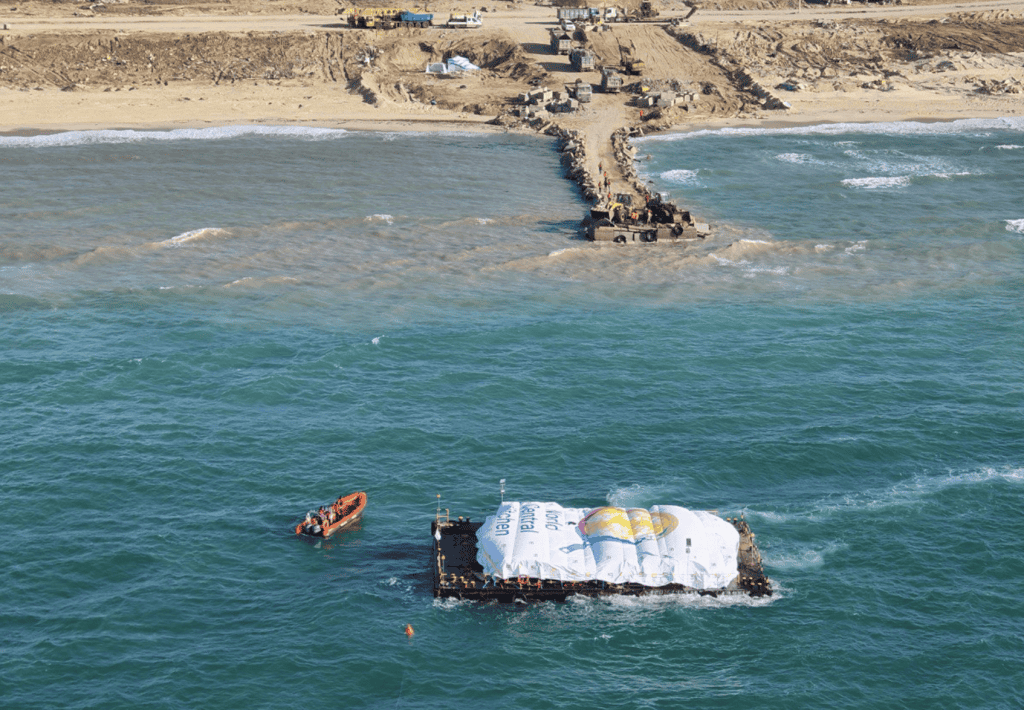
The first delivery of humanitarian aid by sea to Gaza occurred on March 15. The Israel Defense Forces said that 115 tons of food and water arrived via a barge that was towed to Gaza by a ship called Open Arms which is run by a Spanish charity of the same name. Open Arms departed Cyprus on March 12 and arrived off the coast of Gaza on March 15.
The maritime corridor is supported by Cyprus. The first shipment was a “highly complex mission,” according to the organizers. The organization World Central Kitchen, founded by chef Jose Andres, is partnering with Open Arms with support from the United Arab Emirates. The European Commission has supported the maritime corridor as well, hoping to use smaller vessels to move aid to Gaza. The US Army is expected to construct a floating pier off the coast. The four ships involved in that mission are making their way slowly across the Atlantic after departing from Charleston on the coast of the United States on March 15.
The first shipment to Gaza arrived off the coast, and goods were unloaded onto what looks like an artificial pier that Israel has recently built on the coast. Images of the pier show a dirt track built on top of concrete blocks and other earthworks. The IDF says that the arrival of the shipment took place in coordination with the Coordinator of Government Activities in the Territories (COGAT), the IDF arm that deals with civil affairs and other issues in the West Bank. It is also tasked also with coordinating humanitarian aid in Gaza.
The IDF says that at the aid arrives on the coast, Israeli naval and ground forces are deployed to secure the area. The website Vessel Finder, which shows the locations of ships, appeared to show the Open Arms ship off the coast of central Gaza, southwest of Gaza City. This area of Gaza is where the IDF has constructed a road and corridor of security control that bisects Gaza, essentially putting IDF forces astride a rural area of fields south of Gaza City. This is called the Netzarim corridor, named after a former Jewish settlement that once existed here prior to Israel’s disengagement from Gaza in 2005. It is expected that this route will be maintained by Israel for the foreseeable future in an effort to facilitate ease of security control and humanitarian aid access.
According to the IDF, the first shipment included “130 pallets of humanitarian equipment, 115 tons of food and water, which were transferred to 12 WCK trucks, which will distribute them to the northern Gaza Strip. This is part of the broader humanitarian effort in the Gaza Strip being led by the United Arab Emirates and conducted in coordination with Israel.”
All of the items being moved to Gaza are inspected before they are offloaded. “It is important to emphasize that the delivery of humanitarian aid does not affect the maritime blockade,” the IDF notes. What this means is that shipments must be in coordination with the IDF.
The focus on humanitarian aid is becoming a central feature of the new phase of the war in Gaza. The IDF said on March 12 that six trucks with aid entered Gaza via what the IDF refers to as the 96th gate. “This was done as part of a pilot in order to prevent the Hamas terrorist organization from taking over the aid.” As with the maritime shipments, the IDF also inspected this shipment. Land shipments are inspected at Kerem Shalom on the border of Israel, Egypt and Gaza. The WFP shipment was also coordinated with the US. “Furthermore, over 1,000 aid packages have been airdropped into the Gaza Strip in over 12 airdrops by foreign countries during the last week,” the IDF said on March 14. Another convoy of 31 trucks entered Gaza on March 14.
The IDF has also said that Palestinian gunmen shot at crowds of people trying to obtain aid in Zaytun, an area south of Gaza City. “About an hour before the entry of the aid convoy last night, Palestinian gunmen were seen opening fire in the midst of a crowd of Gazan civilians,” the IDF said.







